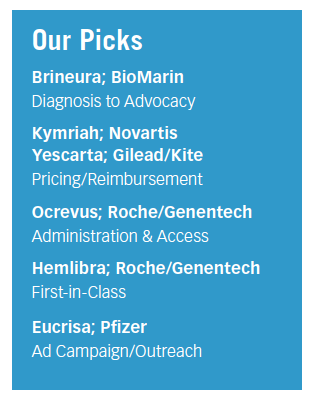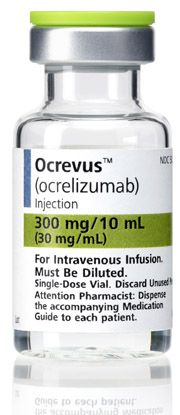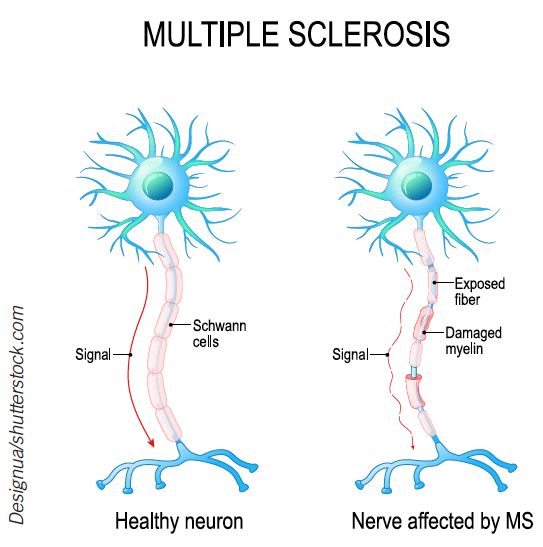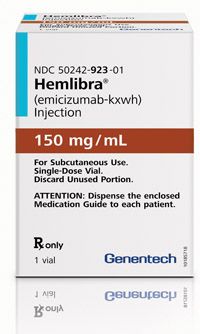Brands of the Year: Promise and Challenge
Pharmaceutical Executive
In its 12th annual feature, Pharm Exec builds on the revamped approach it introduced last year in spotlighting notable biopharma brands, profiling a new round of products that are making waves in five key areas in healthcare and R&D.
In our 12th annual feature, Pharm Exec builds on the revamped approach we introduced last year in spotlighting notable biopharma brands, profiling a new round of products-selected with the help of our Editorial Advisory Board-that are making waves in five key areas in healthcare and R&D.

Diagnosis to Advocacy
Brineura
‘Precision’ Hope Amid the Heartbreak
“In a world of bad diseases, this one is particularly cruel,” Chuck Bucklar, group vice president for commercial in North America for BioMarin Pharmaceutical, told Pharm Exec. Children born with the CLN2 form of Batten disease develop normally for the first two to three years of life, with little sign of what is to come. Maybe a speaking delay, but nothing that would alarm a parent or pediatrician. If seizures present, they tend to be treated as epilepsy. The disease progresses rapidly with most affected children losing the ability to walk and talk by six years of age. After that, symptoms are followed by dementia and blindness; feeding and everyday needs become extremely difficult, and then death occurs between the ages of eight and 12.
Margie Frazier, executive director for the Batten Disease Support and Research Association (BDSRA), says, “Parents literally watch their three-year-old disintegrate before their eyes. It is one of the most frightening things to go through as a parent.”
This group of lysosomal storage disorders is considered ultra-rare and, therefore, hard to diagnose. Documented reports show pockets of pediatricians and scientists who recognized the disease and worked to advance and share knowledge, but the doctors who finally diagnosed CLN2 Batten in a child had no hope to give families. Then came Brineura.
Articles (here and here) and videos that have emerged about Brineura form a rich story of how the medicine finally came to be. One trial. Twenty-four patients. A natural history cohort. Four years to approval. First therapy available in its disease class since discovery in 1903. From scientists at Rutgers University in New Jersey who discovered the TPP1 gene and its mutations that resulted in CLN2, which then started the chain to find an enzyme replacement therapy.
Parent advocates Tracy and Jen VanHoutan tracked down researchers and physicians in an attempt to save their son, and kept the fundraising and advocacy momentum going even after he died and his younger sister was diagnosed. When by sheer coincidence a man donated his dachshund suffering from motor deterioration to scientists, they found the same enzyme deficiency. From mice to dogs, researchers were able to find an enzyme
Courtesy of BioMarin

replacement that worked, with a difficult but viable delivery system.
BioMarin started trials in 2013. Safety and efficacy data was collected over 96 weeks in a non-randomized, single-arm, dose-escalation clinical study of patients with CLN2 disease compared to untreated patients from a natural history cohort. Of the 22 patients treated with Brineura and evaluated for efficacy at week 96, 21 (95%) did not decline, and only the patient who terminated early was deemed to have a decline in the motor domain of the CLN2 Clinical Rating Scale. On April 27, 2017, the FDA approved the prescription medication used to slow loss of ability to walk or crawl in symptomatic pediatric patients three years of age and older with late infantile neuronal ceroid lipofuscinosis type 2 (CLN2), also known as tripeptidyl peptidase 1 (TPP1) deficiency. The European Commission approved the product about a month later.
When Brineura was approved, Jean-Jacques Bienaimé, BioMarin’s chairman and CEO, said in a statement: “Treating children with CLN2 disease requires an extraordinary amount of collaboration between families, hospitals, advocates, and physicians. We are grateful for the partnership of all those involved and look forward to continuing to work together to make Brineura accessible to children who may benefit.”
Brineura received the 2017 Popular Science “Best of What’s New” award in the health category, and the WORLDSymposium 2018 New Treatment Award.
Complex delivery
Children receive Brineura through an intracranial port directly into the brain. The therapy is stored at -20 degrees. Bucklar says this complexity has tested both the hospitals’ (mostly large children’s centers) abilities and BioMarin’s facilitation skills. “It involves different departments in the hospitals, some that don’t usually work with each other,” he notes. “We have the peds/neuro department, with genetics and neurosurgery (to put in the port), with the ped/hem/onc because they are the ones that in standard operating procedures usually perform ports, the pharmacy for refrigeration and thawing requirements, and the hem/onc nurses, who are used to much shorter infusion periods.”
In addition, the therapy is given every two weeks and each infusion is four hours, so the hospitals need to build a system and protocols that are sustainable. Currently, there are just under 20 centers up and running that administer Brineura. These locations also change as parents are moving closer to the centers, or centers are being trained to accommodate local patients.
Physician awareness
As mentioned, CLN2 takes a long time to be diagnosed. Frazier says the diagnosis journey for patients is typically three to five years. In many cases, she notes, they are treating the symptoms of epilepsy or speech therapy, but not the root cause.
Catherine Pajak, senior director of marketing for BioMarin, says the ability to diagnosis early is one of the things that keeps her up at night. To support early testing for children who experience seizures, BioMarin launched “Behind the Seizure,” a no-cost genetic testing program. In conjunction with commercial lab Invitae, the 125-gene panel tests for different types of seizures. The testing is leading to more accurate diagnosis of genetic causes of epilepsy, as well as CLN2. A recent paper presented at the American College of Medical Genetics and Genomics (view: https://bit.ly/2qX6KTs) found that patients were diagnosed at age three vs. age five previously, and based on clinician notes on ordering the panel, two of the three children who tested positive for TPP1 were not even suspected to have CLN2.
Pajak sees this as a clear example of the success of precision medicine. “It becomes a domino effect in research,” she says. “You identify different types of epilepsy or gene variants more quickly, so they can be diagnosed more quickly; then you learn more about the disease, which goes back to more research.”
BioMarin representatives and BDSRA’s Frazier acknowledge that Brineura would not be here without the efforts of the VanHoutan’s. While their own children affected by Batten disease were not able to benefit from a treatment, they recognize that access to Brineura will help other children, and they continue to feel a strong connection to the Batten community.
- Lisa Henderson
The rest of Pharm Exec’s Brands of the Year are profiled ahead ...
Pricing/Reimbursement
Kymriah and Yescarta
Leading the CAR-T Race
Last year’s US approvals of Novartis’ Kymriah (tisagenlecleucel)-for the treatment of B-cell acute lymphoblastic leukemia (ALL) in children and young adults with limited treatment options-and Kite Pharma’s Yescarta (axicabtagene ciloleucel)-for adult patients with relapsed or refractory large B-cell lymphoma after two or more lines of systemic therapy-pushed chimeric antigen receptor T cell (CAR-T) therapies into the headlines and ushered in what MD Magazine’s Jared Kaltwasser, in a March article, called “a brave new world of gene therapy.” Both treatments involve a process of extracting a patient’s T cells and genetically reengineering them, using a disarmed virus, to produce on their surface chimeric antigen receptors, which allow the T cells to recognize and attach to an antigen (CD19) found on B cells. The engineered T cells are multiplied in the lab and then reinfused into the patient’s body, where they recognize and attack the cancer cells while leaving healthy cells unharmed. After years of discussions and promises about personalized cancer therapies, Cliff Kalb of C. Kalb & Associates says of the CAR-T breakthrough that “finally, the dream has begun to materialize into a commercial reality.”
First-in-class Kymriah had its beginnings in 2012 when Novartis began collaborating with the University of

Pennsylvania, with the aim of bringing “a paradigm-changing therapy to cancer patients in dire need,” as Novartis Oncology’s former global CEO, Bruno Strigini, told Pharm Exec in a January cover story. The treatment’s potential was shown in clinical trials led by Dr. Stephan Grupp of the Children’s Hospital of Philadelphia and the University of Pennsylvania’s Perelman School of Medicine, in which 82.5% of patients who were given Kymriah achieved either complete remission, or complete remission with incomplete blood count recovery, within three months. Grupp would help guide Kymriah to its FDA approval on August 31, 2017.
Kite Pharma, acquired in October 2017 by Gilead Sciences for $11.9 billion, Gilead’s biggest ever deal, was basically a firm focused on bringing Yescarta to market, and its development of the treatment “represented a major shift in the classical paradigm for the development, production, and marketing of a pharmaceutical intervention that could offer a cure,” Kalb told Pharm Exec. The level of risk was compounded by the need
to “not only shepherd a new product through the development and clinical trial process for approval for traditional safety and efficacy.” While the process is complicated and not always successful, response rates have been so dramatically improved over the standard of care, FDA designated Yescarta a breakthrough therapy and approved it on October 18, 2017, less than two months after Kymriah was greenlighted.
Both Kymriah and Yescarta need to be administered in specialized treatment centers, and these individualized approaches to modifying a patient’s own cells to fight cancer “[bring] all sorts of additional complexities in terms of manufacturing, handling, and logistics,” Strigini explained. To address these

complexities, Novartis has developed “custom-made patient access programs to support safe and timely delivery,” while Kite has invested in facilities around the country to allow patients local access to its procedure.
The price of breakthrough
The introduction of CAR-T therapies brings challenges. “Participating patients face the risk of cytokine release syndrome, a potentially life-threatening reaction, and other neurological toxicities, so there is still a long way to go to improve safety,” says Kalb. However, he adds, “the bigger challenge may be in the pricing and reimbursement arena, where access may be limited by the healthcare system’s ability to cover proposed commercial prices in the hundreds of thousands of dollars.”
Kymriah’s and Yescarta’s price tags are $475,000 and $373,000 per treatment, respectively. Strigini told Pharm Exec that “we put a great deal of thought into how to price Kymriah,” including taking account of independent evaluations such as those of the UK’s National Institute for Health and Care Excellence (NICE), “which estimated a cost-effective price of between $600,000 and $700,000.” He emphasized that Kymriah is intended to be delivered to each patient just once as a “one-time, highly effective treatment.”
In a March report, the Institute for Clinical and Economic Review (ICER) agreed that CAR T-cell therapies are cost-effective for B-cell cancers. Compared to clofarabine, a standard chemotherapy for patients with B-ALL, for example, Kymriah was said to provide 7.18 more quality-adjusted life years (QALYs), with an incremental cost per QALY of $57,093. ICER calculated that Yescarta would provide 3.59 more QALYs than other chemotherapy regimens, with a cost per QALY of $145,158. Both treatments were deemed to fall within the acceptable cost-effectiveness thresholds.
But while the treatments may be cost-effective overall, the short-term cost may exceed the annual budget threshold. As a result, Kaltwasser notes that insurers have been cautious, “evaluating treatment requests on a case-by-case basis,” and some patient advocacy groups have “complained that the high price tags are limiting patient access.” A Gilead spokesperson, in a December Bloomberg report, said the company was “confident that Yescarta will be covered by payers,” that the “‘vast majority’ of commercial payers have confirmed coverage,” and pledged to “engage actively with Medicare to ensure we are doing all we can to support access.”
For Kymriah, Strigini said that Novartis has put in place a “first-of-a-kind arrangement” with the Centers for Medicare and Medicaid Services (CMS), which “includes an outcome-based approach and indication-based pricing,” and for which the company will only receive payment for patients who show significant improvement within a month of receiving the treatment.
On April 1, CMS reported that it would pay $395,380 to health providers who use Yescarta; the Medicare payment rate for Kymriah was set at $500,839. Commentators pointed out, however, that the treatments will incur additional costs. Ahead of CAR-T treatment, patients must undergo a process of “lymphodepletion,” using high doses of chemotherapy, to make room in the body for the genetically modified cells. In some estimations, the additional hospital fees could push the total cost per patient to over $1 million. Kalb expects both Novartis and Gilead/Kite to address these concerns to make the treatments available to patients who desperately need them, while GlobalData, in a report published last month, predicts that the second half of 2018 will bring “price adjustments in the initial wave of approved CAR-T drugs.”
The gene-therapy future
While Novartis’ Kymriah was the first in the new class of cell therapies to be approved, Kalb says that “the initial label was somewhat weaker than Yescarta, which may turn out to be best in class in the longer run.” And with Gilead as Kite’s new parent firm, it “now has a strong source of financial support to fully take advantage of their position in this emerging new immunotherapy field.” But Bloomberg indicated that while Gilead/Kite “currently has the market to itself for hard-to-treat lymphoma … its rivals are drawing closer,” pointing out that Novartis has also filed for FDA approval of Kymriah for the same form of blood cancer, with Juno Therapeutics following on its heels. Spark Therapeutics’ gene therapy, Luxturna, also “made its own history,” wrote Kaltwasser, by becoming the first gene therapy approved (in December) for an inherited disease (inherited retinal disease); he added that Kymriah, Yescarta, and Luxturna “won’t be the lone gene therapies for much longer.”
It’s still early days in the personalized-care quest to harness and strengthen the body’s immune system. Kymriah and Yescarta both treat liquid tumors, rather than solid tumors; for the latter, research into CAR-T treatments has yielded less success. But with interest in the gene therapy field now booming, a number of startups are advancing into the solid tumor area. The initial success of Kymriah and Yescarta, Kalb points out, has “stimulated widespread industry interest in joining in and developing even more innovative and non-traditional approaches to care.”
- Julian Upton
Administration & Access

Ocrevus
MS Breakthrough, Roadblock?
Genentech’s Ocrevus has made quite the splash when it comes to novel and highly sought approaches to slowing the progression of multiple sclerosis (MS), for which there is no cure. In March 2017, Ocrevus became the first and only approved disease-modifying therapy for primary progressive MS (PPMS), one of the most disabling forms of the autoimmune disease, when the drug was cleared by the FDA. Ocrevus, a monoclonal antibody, was also approved in the US for relapsing MS (RMS), the most common form of the condition. In January, the drug was cleared in the European Union for both indications.
Ocrevus’ US approval was based on its demonstrating superior efficacy on the three major markers of disease activity compared with EMD Serono and Pfizer’s Rebif. According to Genentech, in two identical RMS Phase III studies (OPERA I and OPERA II), Ocrevus demonstrated superior efficacy by reducing relapses per year by nearly half, slowing the worsening of disability and significantly reducing MRI lesions compared with Rebif (high-dose interferon beta-1a) over the two-year controlled treatment period. A similar proportion of people in the Ocrevus group experienced a low rate of serious adverse events (AEs) and serious infections compared with those in the Rebif arm.
In a separate PPMS Phase III study, Ocrevus was the first treatment to significantly slow disability progression and reduce signs of disease activity in the brain (MRI lesions) compared with placebo with a median follow-up of three years. Again, both arms experienced a similar proportion of AEs and a low rate of serious AEs.
“Until now, no FDA-approved treatment has been available to the primary progressive MS community, and some people with relapsing forms of MS continue to experience disease activity and disability progression despite available therapies,” said Dr. Sandra Horning, chief medical officer and head of global product development, Roche (Genentech’s parent company), in a press release. “We believe Ocrevus, given every six months, has the potential to change the disease course for people with MS, and we are committed to helping those who can benefit gain access to our medicine.”
According to published reports, however, gaining access has been a challenge for some patients, given the fact that Ocrevus must be administered intravenously at a clinic. A December article on Multiple Sclerosis News Today reported that some physicians are not prescribing the therapy because the infusion centers are too far away from where patients live.
While patients don’t have to travel to infusions center daily, there is a time commitment and multiple visits are required, which could create obstacles depending on a patient’s location. The first dose of Ocrevus is a 600 mg dose administered as two separate 300 mg IV infusions given two weeks apart over 2.5 hours. Every subsequent dose is administered as a single 600 mg IV infusion every six months given over 3.5 hours.
These potential challenges in drug delivery, coupled with Ocrevus’ promise for patients, are what led us to feature the product as part of this year’s Brands coverage. Genentech declined to provide Pharm Exec with an overview of Ocrevus’ delivery challenges, noting, however, that patients, respective of their individual situations, should contact their physicians for much of that information.
“Genentech remains committed to seeking appropriate access to Ocrevus for all patients with relapsing or primary progressive forms of MS,” Kimberly Muscara, a company spokesperson, told Pharm Exec, also directing patients to call the company’s Access Solutions program.
It’s unclear the number of US clinics that are approved to administer Ocrevus, or where a majority of them are located. Muscara did confirm that Ocrevus can only be administered in an infusion center and said Genentech trains infusion center teams on how to administer the drug. With limited details available on access, whether reported difficulties in finding infusion centers close to patients is a temporary problem that

will lessen as more centers are trained on Ocrevus administration and start to offer the service at their clinics, is also unclear.
One aspect that appears more certain is Ocrevus’ pricing structure. “Genentech was recognized by the National MS Society for the leadership we showed with our pricing strategy, and they encouraged other companies to follow suit to create a drug pricing trend that keeps patients first,” says Muscara. “The current price for Ocrevus remains at the launch WAC (wholesale acquisition cost) price of $65,000, which is now 31% below the annual price (WAC) of Rebif ($94,641). We believe our unique pricing strategy along with Ocrevus’ favorable clinical profile and six-month administration schedule has resulted in positive coverage decisions that have improved access for patients.”
According to Muscara, Ocrevus has been “well-received” by the payer community and “we are happy to see the insurance coverage decisions that have been made.” Late last month, Roche reported $486 million in first-quarter sales for Ocrevus. The drug’s market share has reportedly grown to 7% since its launch.
Genentech’s Access Solutions program can help those patients prescribed Ocrevus with cost. The program includes Ocrevus “patient navigators” and provides information about coverage, reimbursement, and product distribution. Assistance, Muscara says, is available to patients throughout their treatment, including access, reimbursement, and infusion coordination support.
- Michelle Maskaly
First-in-Class

Hemlibra
Quality-of-Life Boost in Hemophilia
Nearly two decades have passed since new medicines for hemophilia A with inhibitors have surfaced. So, when Hemlibra was approved by the FDA late last year for routine prophylaxis to prevent or reduce the amount of bleeding episodes in children and adults with hemophilia A with factor VIII inhibitors, the shift in the treatment process was welcomed.
Hemlibra, made by Genentech, is the only self-administered (subcutaneous injection) hemophilia A with inhibitors treatment, and is only administered once a week. This is a vast improvement over such therapies that take around 45 minutes to administer every other day, or more involved treatments that last two hours and are required multiple times a week.
Hemlibra has already demonstrated a tangible positive impact in the hemophilia A patient community. According to Dr. Gallia Levy, associate group medical director, Genentech, Hemlibra’s outcomes in patients has resulted in children missing less school, adolescents who couldn’t play sports for fear of bleeding are able to do so now, and adults who were not able to work are holding down jobs.
Meanwhile, Genentech says it’s committed to further advancing Hemlibra and finding new ways to help various segments of the patient population. In April, the FDA granted the drug breakthrough therapy designation for patients with hemophilia A without factor VIII inhibitors. Hemlibra's first Breakthrough Therapy Designation for patients with hemophilia A with factor VIII inhibitors was granted in Spetember 2015.
In clinical studies, Genentech is also pursuing less frequent dosing options for Hemlibra, mindful of patient quality of life and drug adherence factors. Two trials, Levy says, are exploring dosing every two weeks and every four weeks, respectively, potentially allowing for the choice of a dosing option for individual patients. According to Levy, the two-week dosing study showed a statistically significant and clinically meaningful reduction in treated bleeds in patients 12 years of age or older with hemophilia A without inhibitors who received Hemlibra prophylaxis every week or every other week, compared to those receiving no prophylaxis.
Although it’s too soon to tell, the significant decrease in the time it takes to administer Hemlibra also has the potential to improve adherence rates among hemophilia A patients.
Safety ripples
Amid Hemlibra’s successful approval and status as a breakthrough therapy, concerns have emerged regarding safety. Recently, it was reported that five deaths were recorded among hemophilia patients taking Hemlibra-bringing the risk-to-benefit ratio into question.
“As of the end of March, more than 600 people with hemophilia A with or without factor VIII inhibitors have been treated with Hemlibra globally, including in clinical trials,” Levy told Pharm Exec. “Since 2016, five adults with hemophilia A with inhibitors who were taking Hemlibra have passed away. For each individual, the treating physician or investigator’s assessment was that the cause of death was unrelated to Hemlibra.”
Genentech says it has made every attempt to investigate each report thoroughly to ensure continued patient safety. Levy stresses the importance of understanding the reality that people with hemophilia A may face serious health risks and life-threatening complications because of the nature of the disease, regardless of treatment.
“In particular, people who develop inhibitors to factor VIII are at a 70% greater risk for death compared to those without inhibitors,” she says. “Three of the adults who passed away were taking Hemlibra through a request from their physician for compassionate use.” Compassionate use provides access to investigational medicines for patients with serious or life-threatening conditions who have exhausted all other treatment options.
According to published reports in late April, including one on Endpoints News, Roche did acknowledge the first incident where a hemophilia patient developed anti-drug antibodies that resulted in reduced efficacy of Hemlibra. In a statement cited in the report, the company said, “Anti-drug antibodies to Hemlibra may affect whether the medicine works, but they do not change the severity of the underlying disorder.”
Levy told Pharm Exec that Genentech is developing a dedicated Hemlibra safety website that will update on an ongoing basis. “Patient safety is very important to us, which is why we have systems and processes in place to monitor the safety of all our medicines, including Hemlibra,” she says.
Pricing
Despite Hemlibra’s hefty list price of $482,000 for the first year of treatment and then about $448,000 per year after that, the totals are reportedly less than half the price of Shire drug FEIBA, the only other approved prophylactic treatment for the indicated hemophilia A population.
In March, Hemlibra was reported as cost-effective by the Institute for Clinical and Economic Review (ICER) after an assessment of adults, adolescents, and children with hemophilia A with inhibitors who will not be treated with immune tolerance induction (ITI) or for whom ITI has been unsuccessful. The report found that Hemlibra offers important improvements in outcomes for people with hemophilia A and inhibitors to factor VIII, while lowering costs associated with the treatment of this condition.
- Christen Harm
Ad Campaign/Outreach
Eucrisa
Insights that Impact
Most brand strategists today believe the best outreach efforts in the world of consumer advertising nimbly tap into aspects of everyday life, using identified specific insights to connect and speak with customers on approachable, uniquely “real” levels. Though it may appear an obvious strategy, in the often-complicated and muddled arena of pharmaceutical direct-to-consumer (DTC) advertising, it’s a relatively new evolution in tactics, and one that could ultimately help improve coordination along the healthcare treatment path-potentially benefiting manufacturers and patients alike.
“[The ads] are not nearly as clinical-looking as they used to be; they’re much more about lifestyle and trying to base them on consumer insight,” Kimberly Orton, managing director, RedSky Strategy, a brand consulting services firm, told Pharm Exec. “You’re talking to [patients] in the best way possible. All of a sudden they’re looking at it saying, ‘wow, that makes sense to me.’ I think [pharma companies] figured out that’s the better way to communicate.”
One example from the past year that has leveraged the strategy effectively in Eucrisa, which in December 2016, became the first new FDA-approved drug for eczema, the chronic inflammatory skin disease, in more than a decade. The topical treatment, made by Pfizer (which acquired Eucrisa via its $4.5-billion acquisition of Anacor in June 2016), is the first approved nonsteroidal to block the enzyme phosphodiesterase 4 (PDE4) to treat mild-to-moderate eczema, also known as atopic dermatitis, for people ages two and older. Though corticosteroids are considered first-line therapy in battling eczema-commonly characterized by painful and bothersome breakouts/flare-ups or persistent rash, red skin, and itchiness-many patients are said to be “steroid-phobic.” Harmful side effects such as hypopigmentation and skin atrophy can also come with repeated use of a steroid cream. Eucrisa, a natural cream applied twice daily, showed in pivotal clinical trials in 1,522 patients to achieve greater response vs. placebo, with clear or almost clear skin after 28 days of treatment.
In the US, 10% to 20% of young people suffer from eczema, with the condition affecting more than 31 million children and adults overall, according to the National Eczema Association.
Beating to the punch Sanofi and Regeneron’s Dupixent, approved last March as the first biologic for eczema (targeting adults only with moderate-to-severe cases), Pfizer launched a national TV ad campaign for Eucrisa last August, spending a reported $2.2 million on its first ad, “Nose to Toes.” The 30-second spot opens with a voiceover “[Eucrisa] can be used almost everywhere on almost everybody,” and then features children,

participating in various activities, asking in response, “the arm of an arm wrestler?” “the back of a quarterback?” and “the face of a fairy?” It follows with a little boy, in pajamas ready for bed, exclaiming, “and it’s steroid free.” The ad, as of late April, had 3,702 national airings, according to iSpot.tv. To date, Pfizer has done four ads for Eucrisa, and though emphasizing its unique reach in the pediatric space, appealing to parents and caregivers, the company has prominently depicted active adult patients as well, including a 30-something female rancher asking, “the hand of a ranch hand?” and an older woman busily stitching on the couch wondering, “the knee of a needle-pointer?”
“They’ve done a good job of storytelling and making it catchy and using clever wordplay,” says Orton. “A lot of people say, ‘oh, if it’s mild to moderate, just live with it; it’s not that bad.’ But the ads are keying into the insight which is, it’s about you and there could be something that would make you better. ... When things are approachable, it feels like, ‘that’s for me, and I’m okay asking my doctor about it.’” Orton believes the insight conveyed meets what she calls the 4Rs: it’s relevant to the brand, resonates with the target viewer, invokes a reaction, and shows everyday realities.
Pfizer is hoping to capitalize on being the first to market in a likely new wave of product launches for eczema. Dupixent TV ads began airing in November. EvaluatePharma estimates 2022 sales of Eucrisa at $1.3 billion. The drug’s most common side effect is application site pain, including burning or stinging.
“First to market is huge because you get to decide what’s differentiated, get to talk to the target first,” Orton told Pharm Exec. “Someone coming on second has to figure out how to do it now.”
-Michael Christel

FDA Grants Priority Review to Regeneron’s Eylea for Macular Edema Following Retinal Vein Occlusion
April 18th 2025Regulatory action was based on data from the Phase III QUASAR trial, which demonstrated that Eylea HD dosed every eight weeks achieved non-inferior visual acuity outcomes compared to Eylea in patients with macular edema following retinal vein occlusion.
Addressing Disparities in Psoriasis Trials: Takeda's Strategies for Inclusivity in Clinical Research
April 14th 2025LaShell Robinson, Head of Global Feasibility and Trial Equity at Takeda, speaks about the company's strategies to engage patients in underrepresented populations in its phase III psoriasis trials.
Study: GLP-1, SGLT2s Linked to Reduced Alzheimer Disease Risk in Patients with Type 2 Diabetes
April 17th 2025A new study found that patients with type 2 diabetes treated with GLP-1 receptor agonists and sodium-glucose cotransporter-2 inhibitors demonstrated lower risks of developing Alzheimer disease compared to other glucose-lowering drugs.
The Misinformation Maze: Navigating Public Health in the Digital Age
March 11th 2025Jennifer Butler, chief commercial officer of Pleio, discusses misinformation's threat to public health, where patients are turning for trustworthy health information, the industry's pivot to peer-to-patient strategies to educate patients, and more.
New Insights Into T Cell Exhaustion and Inflammation in Long COVID
April 17th 2025Nigel McCracken, chief operating officer, Virax Biolabs, discusses new findings that reveal altered cytokine activity and evidence of T cell exhaustion in long COVID patients, providing deeper insight into post-infection immune disruption.